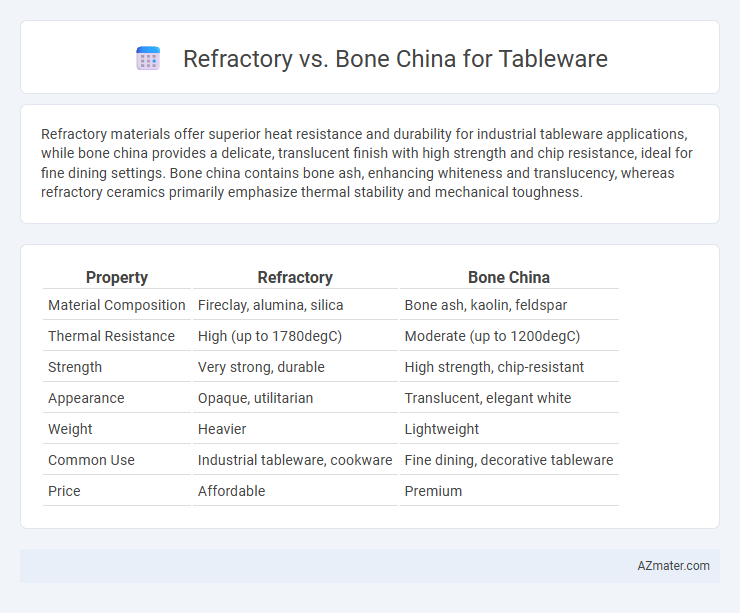Refractory materials offer superior heat resistance and durability for industrial tableware applications, while bone china provides a delicate, translucent finish with high strength and chip resistance, ideal for fine dining settings. Bone china contains bone ash, enhancing whiteness and translucency, whereas refractory ceramics primarily emphasize thermal stability and mechanical toughness.
Table of Comparison
| Property | Refractory | Bone China |
|---|---|---|
| Material Composition | Fireclay, alumina, silica | Bone ash, kaolin, feldspar |
| Thermal Resistance | High (up to 1780degC) | Moderate (up to 1200degC) |
| Strength | Very strong, durable | High strength, chip-resistant |
| Appearance | Opaque, utilitarian | Translucent, elegant white |
| Weight | Heavier | Lightweight |
| Common Use | Industrial tableware, cookware | Fine dining, decorative tableware |
| Price | Affordable | Premium |
Introduction to Tableware Materials
Refractory and bone china are two prominent materials used in tableware, each offering distinct durability and aesthetic qualities. Refractory ceramics are designed to withstand high temperatures and mechanical stress, making them ideal for heavy-duty use and industrial settings. Bone china, known for its translucency, whiteness, and strength due to its bone ash content, is favored for elegant dining experiences and fine table settings.
Understanding Refractory Tableware
Refractory tableware is designed to withstand high temperatures and thermal shock, making it ideal for oven-to-table use and heavy-duty kitchen environments. Unlike bone china, which offers delicate elegance and translucency due to its bone ash content, refractory tableware emphasizes durability and resistance to chipping and cracking. This robust nature allows refractory ceramics to maintain structural integrity under extreme heat, providing practical benefits for both commercial and home use.
Overview of Bone China Tableware
Bone china tableware stands out for its remarkable strength, translucency, and delicate appearance, achieved by incorporating bone ash into the porcelain mixture. This type of ceramic offers exceptional durability and chip resistance, making it ideal for fine dining settings. Its sophisticated finish and lightweight feel distinguish it from refractory ceramics, which prioritize high heat resistance over aesthetic appeal.
Key Differences in Material Composition
Refractory tableware is made from high-temperature resistant clay mixed with alumina and silica, designed to withstand thermal shock and mechanical stress, making it ideal for oven-to-table use. Bone china contains bone ash, feldspar, and kaolin, which create a lightweight, translucent, and highly durable material prized for fine dining and aesthetic appeal. The key difference lies in refractory's emphasis on heat resistance and strength versus bone china's focus on whiteness, translucency, and delicate craftsmanship.
Durability: Refractory vs Bone China
Refractory tableware offers superior durability due to its high resistance to thermal shock and mechanical stress, making it ideal for heavy-use environments. Bone china, while elegant and slightly less dense, provides good durability but is more prone to chipping and cracking compared to refractory ceramics. The composition of refractory materials includes alumina and silica, enhancing toughness, whereas bone china's calcium phosphate content prioritizes translucency and delicate appearance over maximum strength.
Aesthetic Appeal and Design Varieties
Bone china offers a delicate translucency and smooth, glossy finish that enhances aesthetic appeal, making it a popular choice for elegant tableware designs with intricate patterns and pastel hues. Refractory ceramics display a more robust, matte texture with earthy tones, suitable for rustic and contemporary styles emphasizing durability and uniqueness. Both materials provide a wide range of design varieties, but bone china excels in refined, classic aesthetics while refractory appeals to bold, artisanal expressions.
Heat Resistance and Everyday Use
Refractory tableware, designed to withstand extremely high temperatures, offers superior heat resistance ideal for oven-to-table use and frequent microwave heating. Bone china, while elegant and lightweight, provides moderate heat resistance suitable for daily dining but requires more careful handling to avoid thermal shock. For everyday use, refractory tableware combines durability and practicality, whereas bone china excels in aesthetic appeal and refined presentation.
Safety and Health Considerations
Refractory tableware is known for its high thermal resistance and durability, making it safe for sudden temperature changes without cracking or releasing harmful substances. Bone china, composed of bone ash and porcelain, is non-porous and resistant to chipping, reducing bacterial contamination risks and maintaining food safety. Both materials meet strict health standards, but bone china's smoother surface may offer enhanced hygiene benefits for everyday use.
Cost Comparison and Value
Refractory tableware generally offers higher durability and resistance to thermal shock, making it cost-effective for heavy or frequent use despite a higher initial price compared to bone china. Bone china, while typically more expensive upfront due to its refined materials and delicate appearance, provides exceptional translucency and elegance, adding value in fine dining settings or special occasions. Evaluating long-term use and aesthetic appeal is essential for determining whether the robustness of refractory or the sophistication of bone china offers better value.
Choosing the Right Tableware for Your Needs
Refractory tableware offers superior durability and thermal resistance, ideal for heavy-duty use in commercial kitchens or outdoor dining settings where heat endurance is critical. Bone china, known for its delicate translucency and refined elegance, suits formal dining or occasions requiring aesthetic appeal combined with reasonable strength. Selecting tableware depends on prioritizing toughness and heat tolerance with refractory or opting for classic beauty and lightness with bone china to best meet your functional and stylistic needs.

Infographic: Refractory vs Bone china for Tableware
 azmater.com
azmater.com